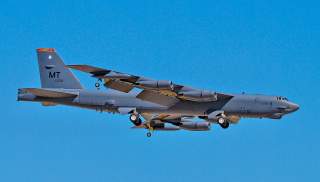No More Atomic Bombs for B-52s
“The overall trend is clear,” a top expert noted. “The B-52 has been gradually shifting from nuclear to conventional missions.”
The U.S. Air Force reportedly has removed from the arsenal of its 76 B-52 heavy bombers two different atomic bombs, for now leaving the eight-engine warplanes with just one aging, nuclear-tipped cruise missile.
A new cruise missile is under development, although it’s not clear how important it will be to the B-52 force as the bomber shifts to non-nuclear roles.
The Air Force confirmed in a September 2019 manual that it had removed from the B-52 compatibility with the B61-7 and B83-1 nuclear gravity bombs.
It’s possible the change to the B-52’s armament actually occurred years ago but for a time escaped notice. Hans Kristensen, a nuclear expert with the Federation of American Scientists, back in 2017 first reported on the removal of the nuclear bombs from the B-52’s arsenal.
Kristensen had noticed budget documents for fiscal year 2018 that listed only the B-2 stealth bomber and fighter aircraft as carriers of the B61 and B83 bombers.
But it’s possible the Air Force removed the atomic bombs even earlier. Documents from 2010 hinted that the flying branch no longer assigned the lumbering, 1960s-vintage bombers to the nuclear-bombing mission.
The rationale was clear. “The B-52 is no longer considered survivable enough to slip through modern air-defenses and drop nuclear gravity bombs on enemy territory,” Kristensen explained. Slow and lacking in stealth features, the B-52 increasingly performs stand-off missions for the Air Force, leaving penetrating missions to nimbler fighters or to B-2 stealth bombers.
But the B-52 still has a nuclear role. Forty-six of the planes are compatible with the AGM-86B nuclear cruise missile. The 2010 New Strategic Arms Reduction Treaty between the United States and Russia limits both countries each to just 60 deployed, nuclear-capable heavy bombers. For the United States, that means the 46 B-52s plus 16 of the 20 B-2s.
With the new B-21 stealth bomber on track to enter USAF service in the late 2020s and eventually carry the new Long-Range Stand-Off nuclear cruise missile, the Air Force is planning for a non-nuclear future for the B-52s, which with upgrades could continue flying into the 2050s. The B-52s are getting new electronics and engines as part of the $32-billion upgrade effort.
The upgrades include compatibility with the new, conventional Joint Air-to-Surface Standoff Missile Extended-Range cruise missile as well as a non-nuclear hypersonic missile the Air Force is developing. While B-52s could carry LRSO nuclear missiles until the venerable bombers finally retire, the bomber’s atomic role looks set to decrease in importance.
“The overall trend is clear,” Kristensen noted. “The B-52 has been gradually shifting from nuclear to conventional missions.”
“Given that the new LRSO will also be integrated on the B-2 and the new B-21 bombers, and the B-52 now has long-range conventional standoff JASSM-ER missiles, the B-52 could probably be phased out of the nuclear mission when the [current AGM-86B cruise missile] retires in the late-2020s,” Kristensen wrote.
The removal of older B61s and B83s from the B-52 fleet wasn’t without deception on the part of the Air Force. “The apparent removal of the B-52 from the nuclear gravity bomb mission is particularly important now because [National Nuclear Security Agency, which oversees America’s nuclear weapons] and the military are promising that once they get the new B61-12 guided nuclear bomb then the overall number of nuclear gravity bombs in the stockpile can be reduced by 50 percent,” Kristensen explained.
“That promise was an important sales pitch in convincing the Obama administration that the B61-12 modernization was consistent with the goal of reducing the number of nuclear weapons.”
What the Air Force and nuclear-weapons lobbyists did not tell Pres. Barack Obama was that the Air Force already planned to cut back on warplanes carrying nuclear gravity bombs. “Most (if not all) of those 50 percent of the nuclear gravity bombs were already in excess of national security needs and could have been retired years ago,” Kristensen noted.
David Axe serves as Defense Editor of the National Interest. He is the author of the graphic novels War Fix, War Is Boring and Machete Squad.

